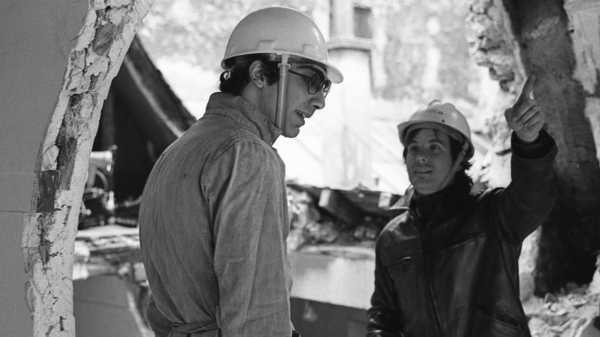
In the film “Day’s End,” the artist Gordon Matta-Clark rides a
whale-size piece of corrugated metal as it is hoisted away from the
wall from which he just cut it. He’s a young man, age thirty-two. The
feat was filmed in the summer of 1975, in Chelsea’s abandoned Pier 52
building, where Matta-Clark attempted to make an “indoor park.” His
silhouette, against the sunlight streaming in from his new view of the
Hudson River, is heroic.
The exodus of middle-class whites and the manufacturing industry had
left New York City sliding toward bankruptcy, and it was at this crucial
point of economic transition that Matta-Clark turned his training in
architecture toward art. He used the tools of construction, demolition,
and scale to grip the edges of the city’s rupture and pull it into
refined shapes, making urban decay (and possibility) more conspicuous.
Of his choice of locations, he said, “The determining factor is the
degree to which my intervention can transform the structure into an act
of communication.”
Move ahead forty years and the city’s debris is from new development,
which has seized vacant space throughout Manhattan and Brooklyn. But the
underlying inequalities that Matta-Clark addressed in his work remain.
It’s fitting that “Day’s End” is currently screening in “Gordon
Matta-Clark: Anarchitect,” an exhibition at the Bronx Museum of the
Arts. The Bronx has become the contemporary battleground where the ideas
that motivated Matta-Clark—gentrification, displacement, who decides a
city’s future—are being disputed.

Gordon Matta-Clark’s “Day’s End” (Pier 52), 1975.
Photograph Courtesy the Estate of Gordon Matta-Clark / ARS / David Zwirner
Matta-Clark was the son of two artists and grew up in downtown
Manhattan, in the fifties and sixties. The activist Jane Jacobs was
defending the neighborhood against Robert Moses’s vision of urban
renewal, which had already cleaved the Bronx in two in order to build
the Cross Bronx Expressway, devastating and displacing communities. Just
before Matta-Clark left for college, the nineteenth-century cast-iron
loft buildings of SoHo were slated for demolition for Moses’s next
project, the Lower Manhattan Expressway. But the urban planner Chester
Rapkin’s study of the area revealed that the lofts were not obsolete but
filled with factories that employed the city’s low-income minorities,
and he, along with Jacobs and other activists, convinced the city that
moral imperative and economic interest should leave the lofts intact.
In the years between Moses’s retreat and Matta-Clark’s return, in 1969,
SoHo’s buildings were increasingly vacated, and unexpected tenants moved
in: artists. The historian Aaron Shkuda, in his book, “The Lofts of
Soho: Gentrification, Art and Industry in New York, 1950-1980,” writes,
“SoHo artist groups posited a new postindustrial future for New York
City that did not rely on slum clearance or urban renewal,” and, in the
process, “established a new role for artists in the contemporary
metropolis: as property developers, urban ‘pioneers,’ and small business
incubators.”
Matta-Clark embodied all three personae. In 1970, he helped open 112
Greene Street, a collaborative gallery and performance space, in a
former rag-picking factory. A year later, he, Caroline Goodden, and Tina
Girouard founded FOOD, often referred to as SoHo’s first restaurant, to
provide jobs, healthy meals, and a community space for the artists
living downtown. In the Bronx Museum show, a 1972 film charts a day at
the restaurant. A long-haired man brews coffee, Goodden haggles at the
Fulton Fish Market, gumbo bubbles on the stove, and, after closing,
another man bakes the next day’s bread.
Beyond the physical innovation of the restaurant’s open kitchen, in
which about three hundred artists worked over the years, Matta-Clark
made space at FOOD for artistic experimentation and performance. On
Sundays, meals were hosted by individual artists, including Yvonne
Rainer, Donald Judd, and Keith Sonnier. Matta-Clark himself devised the
“Matta Bones” dinner, in which necklaces made from the remains of
animals were given out as souvenirs to those who had eaten them. His
widow, Jane Crawford, once said that Matta-Clark “had cooking all
through his mind as a way of assembling people, like choreography.”
“One of the earliest times I can remember using cutting as a way of
redefining a space was at FOOD Restaurant,” Matta-Clark said. The
renovations of that space and 112 Greene Street gave him the idea for
what would become known as his “building cuts,” and he soon made his
first foray, with trips to abandoned buildings in Brooklyn and the
Bronx. He photographed from disorienting angles the odd windows that he
opened, and even took cross-sections of the buildings to exhibit at 112
Greene Street, under the title “Bronx Floors.” The remains of wallpaper
and molding around his dissections emphasized what the artist said of a
later work: “The shadows of the persons who had lived there were still
pretty warm.”

Gordon Matta-Clark’s “Bronx Floors,” 1973.
Photograph Courtesy the Estate of Gordon Matta-Clark / The Bronx Museum of the Arts
Matta Clark’s earliest art had dealt more directly with those people who
were forced out. “Garbage Wall,” made of trash, chicken wire, and
plaster, and “Glass Bricks,” made of melted beer bottles, proposed more
durable alternatives to the cardboard architecture that he saw the
homeless constructing. By 1976, he stated that he hoped his art “would
no longer be concerned with just personal or metaphoric treatment of the
site,” but would finally be “responsive to the express will of its
occupants.” In 1977, he was awarded a Guggenheim Fellowship, to set up a
resource center that Lower East Side youth would design and build,
becoming empowered to alter their own environment. But just a year later
Matta-Clark died, at age thirty-five, a victim of pancreatic cancer, and
the center was never built.
Matta-Clark didn’t witness the massive crises that the city would soon
endure in the AIDS and crack epidemics, nor the money about to pour into
the art and real-estate markets. Not long after his death, the rents
rose in SoHo and artists decamped to nearby neighborhoods. In 1984, the
arts magazine October published Rosalyn Deutsche and Cara Gendel
Ryan’s “The Fine Art of Gentrification,” which ridiculed artists, and
the parade of gallerists trailing them, for their role in the influx of
wealth and the cycle of displacement. “The art world functions
ideologically to exploit the neighborhood for its bohemian or
sensationalist connotations while deflecting attention away from
underlying social, economic, and political processes,” the authors
wrote. “They approach the neighborhood with dominating and possessive
attitudes that transform it into an imaginary site.”
Matta-Clark’s reputation remains well preserved for his good will, but
the art historian Douglas Crimp, in his recent memoir, points out that
the artist’s own “imaginary sites” weren’t always abandoned. Matta-Clark
got away with “Day’s End” because police and dockworkers tended to avoid
the gay men known to go cruising at the piers, the same men whom Matta-Clark locked out when he took possession of the building. A closer
look at a photograph of the FOOD storefront reveals the sign above,
painted with the words “Comidas Criollas,” a testament that
Matta-Clark’s business was not, in fact, the first restaurant in SoHo.
In today’s New York, the “urban pioneers”—those who are most
transforming the cityscape—are not artists but real-estate developers
and land speculators. The city has come to rely heavily on the private
sector to build affordable housing, incentivizing developers to reserve
a percentage of affordable units in market-rate buildings through
promises of rezoning and tax breaks. The Bronx has come under pressure
as speculators turn their attention to its neighborhoods. But in a
reversal of the sixties, when urban renewal in the Bronx served as a
warning to downtown Manhattan, today’s Bronx residents have been
cautioned by the rapid development of other boroughs.
“The Bronx that exists now is because of that community that maintained
it by becoming entrepreneurs and doing what we needed to do to survive,”
the Bronx resident Carmen Vega-Rivera told me. In 1981, she moved to the
borough from the Lower East Side, where she was born and raised. Over
eight years, she served as a curator and associate director at the Bronx
Museum of the Arts, helping to secure its current location, in a former
synagogue on the Grand Concourse. When she moved, she had faith that the
neighborhood would improve, “but the change that I’m seeing right now,”
she said, is “not for me, nor is it for my children.”
In 2005, Mayor Bloomberg began rezoning portions of the Bronx and its
waterfront; the City Planning Commission has recently approved Mayor de
Blasio’s rezoning plan for an industrial stretch of Jerome Avenue. The
plan claims to answer the community’s need for affordable housing, but
it downplays the destructive economic impact of luxury apartment
buildings on auto shops and local businesses, the same omission that
Rapkin identified in Moses’s SoHo plan. What the city is promising won’t
address the dire local need for housing: only twenty per cent of units are
reserved for households making a third of the area’s median income,
which for a family of four is $28,600 or less. Half the community
occupies that income bracket. The area is already among the most
severely rent-burdened in the city; the risk of displacement and
homelessness is catastrophic.
Vega-Rivera is clinging to her apartment in the building that she has
lived in for thirty-seven years. She organized her neighbors against
their landlord’s flagrant negligence, and, even though the building went
into foreclosure, the imminent rezoning coaxed an investor to buy it for
twenty-eight million dollars. The fear now is that the investor will
force out the tenants who endured terrible conditions. “I’m on a fixed
income. My husband’s going to retire,” Vega-Rivera said. “Where am I
going to go when I feel the pressure?” “Poor people and people of color
tend to be invisible when the discussions are entirely about economic
development,” Tom Angotti, a professor emeritus of urban policy and
planning at Hunter College and the Graduate Center, CUNY, told me over
the phone. “Now people are saying, ‘We struggled through the years of
abandonment, we stuck with the city, we put roots down here. We don’t
want to be pushed out.’ ”
Just as Jane Jacobs’s philosophy of the “urban village” has often been
reduced by urban designers to a recommendation for building height and
sidewalk width, the work of Matta-Clark should not be aestheticized in
hindsight, nor should it be lamented as possible only in the context of
a burnt, abandoned city. The films Matta-Clark made of his works’
progress show that his interest was not in the mystery of the feat but
in undoing perceptions of fixity. He wanted to create a narrative for
change, to alert fellow-citizens to the ways that urban space is
imagined and discarded, imposed, and taken.
Matta-Clark seemed aware that he was a seed of development; he made a
nod to the complicated nature of ownership in his work when he said that
“Day’s End” was cut into the shape of a “pie-slice.” When someone
criticized his work as complicit in urban renewal, he defended it by
saying, “I don’t try to make destruction into a beautiful experience.”
He argued that what he was doing was “taking a situation at the last
minute and trying to put it back into an alternative sort of
expression.” But he could not predict that his short lifetime lay on the
brink of the city’s accelerated growth, a concept that has come to be
equated not with the commitment of residents but with the
destructiveness of wealth. The “last minute” to which he referred has in
the intervening years gathered a new meaning. SoHo’s came and went
decades ago, but the Bronx’s is now.
Sourse: newyorker.com






